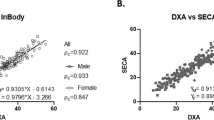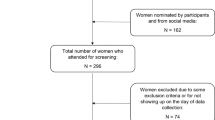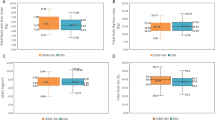Abstract
Objective: To establish the accuracy of bioelectrical impedance analysis (BIA) for the assessment of appendicular body composition in anorexic women.
Design: Cross-sectional study.
Setting: Outpatient University Clinic.
Subjects: A total of 39 anorexic and 25 control women with a mean (s.d.) age of 21 (3) y.
Methods: Total, arm and leg fat-free mass (FFM) were measured by dual-energy X-ray absorptiometry and predicted from total and segmental BIA at 50 kHz. The predictor variable was the resistance index (Rl), that is, the ratio of height 2 to body resistance for the whole body and the ratio of length2/limb resistance for the arm and leg.
Results: Predictive equations developed on controls overestimated total, arm and leg FFM in anorexics (P<0.0001). Population-specific equations gave a satisfactory estimate of total and appendicular FFM in anorexics (P=NS) but had higher percent root mean square errors (RMSEs%) as compared to those developed on controls (8% vs 5% for whole body, 12% vs 10% for arm and 10% vs 8% for leg). The accuracy of the estimate of total and leg FFM in anorexics was improved by adding body weight (Wt) as a predictor with Rl (RMSE%=5% vs 8% and 7% vs 10%, respectively). However, the same accuracy was obtained using Wt alone, suggesting that in anorexics, BIA at 50 kHz is not superior to Wt for assessing total and leg FFM.
Conclusions: BIA shows some potential for the assessment of appendicular body composition in anorexic women. However, Wt is preferable to BIA at 50 kHz on practical grounds. Further studies should consider whether frequencies >50 kHz give better estimates of appendicular composition in anorexics as compared to Wt.
Sponsorship: University of Napoli.
This is a preview of subscription content, access via your institution
Access options
Subscribe to this journal
Receive 12 print issues and online access
$259.00 per year
only $21.58 per issue
Buy this article
- Purchase on Springer Link
- Instant access to full article PDF
Prices may be subject to local taxes which are calculated during checkout
Similar content being viewed by others
References
Bedogni G, Bollea MR, Severi S, Trunfio O, Manzieri AM & Battistini N (1997): The prediction of total body water and extracellular water from bioelectric impedance in obese children. Eur. J. Clin. Nutr. 51, 129–133.
Bedogni G, Polito C, Severi S, Strano CG, Manzieri AM, Alessio M, Iovene A & Battistini N (1996): Altered body water distribution in subjects with juvenile rheumatoid arthritis and its effects on the measurement of water compartments from bioelectric impedance. Eur. J. Clin. Nutr. 50, 335–339.
Brown BH, Karatzas T, Nakielny R & Clarke RG (1988): Determination of upper arm muscle and fat areas using electrical impedance measurements. Physiol. Meas. 9, 47–55.
Cornish BH, Jacobs A, Thomas BJ & Ward C (1999): Optimizing electrode sites for segmental bioimpedance measurements. Physiol. Meas. 20, 241–250.
Deurenberg P (1994): International consensus conference on impedance in body composition. Age Nutr. 5, 142–145.
DSM-IV (1994): Diagnostic standardization manual. Washington: American Psychiatric Association.
Elia M, Fuller NJ, Hardingham CR, Graves M, Screaton N, Dixon AK & Ward LC (2000): Modeling leg sections by bioelectrical impedance analysis, dual-energy X-ray absorptiometry, and anthropometry: assessing segmental muscle volume using magnetic resonance imaging as a reference. Ann. NY Acad. Sci. 904, 298–305.
Frisancho A (1990): Anthropometric Standards for the Assessment of Growth and Nutritional Status. Ann Arbor: The University of Michigan Press.
Fuller NJ, Hardingham CR, Graves M, Screaton N, Dixon AK, Ward LC & Elia M (1999a): Predicting composition of leg sections with anthropometry and bioelectrical impedance analysis, using magnetic resonance imaging as reference. Clin. Sci. 96, 647–657.
Fuller NJ, Hardingham CR, Graves M, Screaton N, Dixon AK, Ward LC & Elia M (1999b): Assessment of limb muscle and adipose tissue by dual-energy X-ray absorptiometry using magnetic resonance imaging for comparison. Int. J. Obes. Relat. Metab. Disord. 23, 1295–1302.
Hannan WJ, Cowen S, Freeman CP & Shapiro CM (1990): Evaluation of bioelectrical impedance analysis for body composition measurements in anorexia nervosa. Physiol. Meas. 11, 209–216.
Heymsfield SB, Gallagher D, Grammes J, Nunez C, Wang Z & Pietrobelli A (1998): Upper extremity skeletal muscle mass: potential of measurement with single frequency bioimpedance analysis. Appl. Radiat. Isot. 49, 473–474.
Heymsfield SB, Mc Manus CB, Smith J, Stevens V & Nixon DW (1982): Anthropometric assessment of muscle mass: revised equations for calculating bone-free muscle area. Am. J. Clin. Nutr. 36, 680–690.
Heymsfield SB, Mc Manus III C, Seitz SB, Nixon DW & Andrews JS (1984): Anthropometric assessment of adult protein-energy malnutrition. In Nutritional Assessment, RA Wright & SB Heymsfield (eds) pp 27–82. Boston: Blackwell Scientific Publications.
Heymsfield SB & Wang Z (1994): Bioimpedance analysis: modeling approach at the five levels of body composition and influence of ethnicity. Age Nutr. 5, 106–110.
Kushner RF, Schoeller DA, Fjeld CR & Danford L (1992): Is the impedance index (Ht2/R) significant in predicting total body water? Am. J. Clin. Nutr. 56, 835–839.
Levine JA, Abboud L, Barry M, Reed JE, Sheedy PF & Jensen MD (2000): Measuring leg muscle and fat mass in humans: comparison of CT and dual-energy X-ray absorptiometry. J. Appl. Physiol. 88, 452–456.
Lohman TG, Roche AF & Martorell R (1988): Anthropometric Standardization Reference Manual. Champaign: Human Kinetics.
Lukaski HC (2000): Assessing regional muscle mass with segmental measurements of bioelectrical impedance in subjects undergoing weight loss. Ann. NY Acad. Sci. 904, 154–158.
Nunez C, Gallagher D, Grammes J, Baumgartner RN, Ross R, Wang Z, Thornton J & Heymsfield SB (1999): Bioimpedance analysis: potential for measuring lower limb skeletal muscle mass. J. Parenter. Enteral Nutr. 23, 96–103.
Organ LW, Bradham B, Gore DT & Lozier SL (1994): Segmental bioelectric impedance analysis: theory and application of a new technique. J. Appl. Physiol. 77, 98–112.
Pietrobelli A, Morini P, Battistini N, Chiumello G, Nunez C & Heymsfield SB (1998): Appendicular skeletal muscle mass: prediction from multiple frequency segmental bioimpedance analysis. Eur. J. Clin. Nutr. 58, 507–511.
Polito A, Cuzzolaro M, Raguzzini A, Censi L & Ferro-Luzzi A (1998): Body composition changes in anorexia nervosa. Eur. J. Clin. Nutr. 52, 655–662.
Scalfi L, Bedogni G, Marra M, Di Biase G, Caldara A, Severi S, Contaldo F & Battistini N (1997): The prediction of total body water from bioelectrical impedance in patients with anorexia nervosa. Br. J. Nutr. 78, 357–365.
Scalfi L, Di Biase G, Coltorti A & Contaldo F (1993): Bioimpedance analysis and resting energy expenditure in undernourished and refed anorectic patients. Eur. J. Clin. Nutr. 47, 61–67.
Shih R, Wang Z, Heo M, Wang W & Heymsfield SB (2000): Lower limb skeletal muscle mass: development of dual-energy X-ray absorptiometry prediction model. J. Appl. Physiol. 89, 1380–1386.
Tagliabue A, Andreoli A, Bertoli S, Pagliato E, Comelli M, Testolin G & De Lorenzo A (2000): Appendicular lean body mass. Prediction by bioelectrical impedance analysis. Ann. NY Acad. Sci. 904, 218–220.
Visser M, Fuerst T, Lang T, Salamone L & Harris TB (1999): Validity of fan-beam dual-energy X-ray absorptiometry for measuring fat-free mass and leg muscle mass. Health, Aging, and Body Composition Study—Dual-Energy X-ray Absorptiometry and Body Composition Working Group. J. Appl. Physiol. 87, 1513–1520.
Wang W, Wang Z, Faith MS, Kotler D, Shih R & Heymsfield SB (1999a): Regional skeletal muscle measurement: evaluation of new dual-energy X-ray absorptiometry model. J. Appl. Physiol. 87, 1163–1171.
Wang ZM, Deurenberg P, Wei W, Pietrobelli A, Baumgartner RN & Heymsfield SB (1999b): Hydration of fat-free body mass: review and critique of a classic body-composition constant. Am. J. Clin. Nutr. 69, 833–841.
Author information
Authors and Affiliations
Contributions
Guarantor: L Scalfi and G Bedogni
Contributors: GB performed statistical analysis and wrote the first draft of the paper; MM, LB, MM and EDF were involved in subjects' enrollment and data collection; EN performed DXA measurements; LS designed the study and contributed to the final version of the manuscript.
Corresponding author
Rights and permissions
About this article
Cite this article
Bedogni, G., Marra, M., Bianchi, L. et al. Comparison of bioelectrical impedance analysis and dual-energy X-ray absorptiometry for the assessment of appendicular body composition in anorexic women. Eur J Clin Nutr 57, 1068–1072 (2003). https://doi.org/10.1038/sj.ejcn.1601643
Published:
Issue Date:
DOI: https://doi.org/10.1038/sj.ejcn.1601643
Keywords
This article is cited by
-
Body composition in young female eating-disorder patients with severe weight loss and controls: evidence from the four-component model and evaluation of DXA
European Journal of Clinical Nutrition (2015)
-
Cross-validation of bioelectrical impedance analysis for the assessment of body composition in a representative sample of 6- to 13-year-old children
European Journal of Clinical Nutrition (2009)
-
Evaluation of air-displacement plethysmography and bioelectrical impedance analysis vs dual-energy X-ray absorptiometry for the assessment of fat-free mass in elderly subjects
European Journal of Clinical Nutrition (2008)
-
Accuracy of eight-polar bioelectrical impedance analysis for the assessment of total and appendicular body composition in peritoneal dialysis patients
European Journal of Clinical Nutrition (2005)
-
Body water distribution in severe obesity and its assessment from eight-polar bioelectrical impedance analysis
European Journal of Clinical Nutrition (2005)



